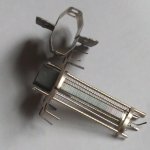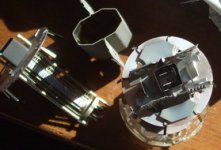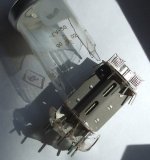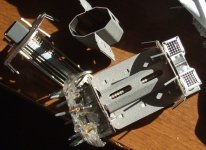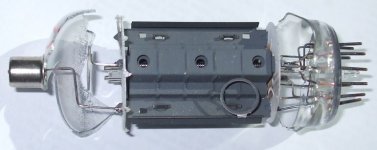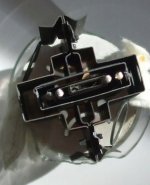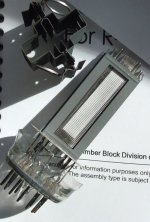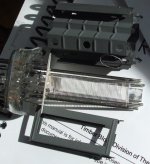I just dissected the internals of a previously destructive tested Russian GU-50 pentode, kindly sent over by jerrys.
I was curious as to whether the g1 and g2 grid assemblies were aligned wire-wise for low screen current. There had been some conflicting posts on GU-50 alignment in the past.
This is (or was) a Ulyanov GU-50, ry-50, tube with the triple converging curves logo and an OTH 57 marking inside of a diamond shape.
Grid 1 has 35 wire wrappings along its length, and grid 2 has 36 wire wrappings along its length. The winding pitch for g1 and g2 is matched and the wires appear to be well aligned. The grid 3 has 24 wire wrappings and is not wire aligned or matched with the inner grids. All the grids have a thin metal band elliptically wrapped around the grid ends (not flat like a frame grid), apparently for alignment during assembly, and the grid 1 bands also shield the uncoated portions of the cathode and are within the confines of the g2 wires.
The cathode appears to be 3 mm wide by 1.5 to 2 mm thick. (elliptical shape cross section with truncated flat edges near the g1 support rods) The grids are also elliptical shape cross section. (g3 has a 8 mm to 15 mm external aspect, g2 has a 5 mm to 9 mm aspect, g1 has a 3 to 5.5 mm aspect) Looks like about 0.66 mm spacing between the cathode surface and g1 wires.
Cathode is 32 mm length for the active coated area. Plate is 35 mm long at center and 38 mm long at supports. Internal plate is 11 mm spacing from side to side above cathode areas. Plate is 21 mm width external along grid supports axis, and 30 mm wide across its own support axis fins. No internal Barkhausen fins on the plate assembly. The long slots along the outer edges of the plate assembly are most likely for performing/observing the grid alignment during assembly. g2 has a heat dissipator radiator box at the top end. Glass envelope is 40 mm external diameter. 0.9 mm glass thichness.
All interior metal is magnetic, so I assume it is Nickel. (the tube pins are not magnetic however) Plate has some kind of gray coating/surface. Interior plate is a shiny metal surface, other than the big black spot where Jerry smoked it! (or was that just normal operation and the tube got drop tested?)
Did I leave anything out?
I was curious as to whether the g1 and g2 grid assemblies were aligned wire-wise for low screen current. There had been some conflicting posts on GU-50 alignment in the past.
This is (or was) a Ulyanov GU-50, ry-50, tube with the triple converging curves logo and an OTH 57 marking inside of a diamond shape.
Grid 1 has 35 wire wrappings along its length, and grid 2 has 36 wire wrappings along its length. The winding pitch for g1 and g2 is matched and the wires appear to be well aligned. The grid 3 has 24 wire wrappings and is not wire aligned or matched with the inner grids. All the grids have a thin metal band elliptically wrapped around the grid ends (not flat like a frame grid), apparently for alignment during assembly, and the grid 1 bands also shield the uncoated portions of the cathode and are within the confines of the g2 wires.
The cathode appears to be 3 mm wide by 1.5 to 2 mm thick. (elliptical shape cross section with truncated flat edges near the g1 support rods) The grids are also elliptical shape cross section. (g3 has a 8 mm to 15 mm external aspect, g2 has a 5 mm to 9 mm aspect, g1 has a 3 to 5.5 mm aspect) Looks like about 0.66 mm spacing between the cathode surface and g1 wires.
Cathode is 32 mm length for the active coated area. Plate is 35 mm long at center and 38 mm long at supports. Internal plate is 11 mm spacing from side to side above cathode areas. Plate is 21 mm width external along grid supports axis, and 30 mm wide across its own support axis fins. No internal Barkhausen fins on the plate assembly. The long slots along the outer edges of the plate assembly are most likely for performing/observing the grid alignment during assembly. g2 has a heat dissipator radiator box at the top end. Glass envelope is 40 mm external diameter. 0.9 mm glass thichness.
All interior metal is magnetic, so I assume it is Nickel. (the tube pins are not magnetic however) Plate has some kind of gray coating/surface. Interior plate is a shiny metal surface, other than the big black spot where Jerry smoked it! (or was that just normal operation and the tube got drop tested?)
Did I leave anything out?
Last edited:
I'm trying to get an old Kodak DVC323 camera working on a borrowed computer here. So far no luck. Got the drivers installed. No application CD in sight. Kodak out of business.
Kodak isn't out of business. But if the camera is too old it might not be supported anymore.
Last edited:
One question, How you feel now after describing the dead body of this tube? Did you learnt any? I am feeling happy with your description but the circus need images.
You like this vacuum tube? wavebourn is one of the few followers of this valve.
You like this vacuum tube? wavebourn is one of the few followers of this valve.
Pictures! I used my Fuji camera instead and reduced the size. (note: the grids were a bit straighter before I mangled them to get the mica off the bottom end)
"One question, How you feel now after describing the dead body of this tube? Did you learnt any? I am feeling happy with your description but the circus need images."
We dutifully lay this GU-50 to rest on this sad day. With rememberances of past and honorable service and best wishes for the next life ................................ Amen.
------------------------------------------------------------------------
I did find a Kodak site for the camera. Was able to get the driver for the camera. But not the included application software:
"The DVC323 comes with KODAK DIGITAL SCIENCE Picture Easy Software.
PICTUREWORKS LIVE Multimedia Application Software captures high quality pictures and still video, controls the camera features, edits and enhances pictures and more."
They have an update to version 3 if you have version 2. But I can't find my CD with version 2 from 1997. Anyone got a copy they could send? I hate to throw it out, it was working so well for curve tracer duty.
"One question, How you feel now after describing the dead body of this tube? Did you learnt any? I am feeling happy with your description but the circus need images."
We dutifully lay this GU-50 to rest on this sad day. With rememberances of past and honorable service and best wishes for the next life ................................ Amen.
------------------------------------------------------------------------
I did find a Kodak site for the camera. Was able to get the driver for the camera. But not the included application software:
"The DVC323 comes with KODAK DIGITAL SCIENCE Picture Easy Software.
PICTUREWORKS LIVE Multimedia Application Software captures high quality pictures and still video, controls the camera features, edits and enhances pictures and more."
They have an update to version 3 if you have version 2. But I can't find my CD with version 2 from 1997. Anyone got a copy they could send? I hate to throw it out, it was working so well for curve tracer duty.
Attachments
Last edited:
While I had the hammer out................,
Couldn't resist busting another dud tube. This was a no go 35LR6 off of Ebay. A TV Horiz. Beamer, so a nice comparison with the GU50 above. Notice the big flat cathode (1300 mA peak rated) and the Barkhausen plates/fins internal to the plate. This is a beam tetrode/pentode, so it has a beam forming box for g3 instead of an actual grid. Grid 1 and 2 wires aligned of course.
61 grid wire wraps across the active cathode area of 33.7 mm length by 6.6 mm width.
Couldn't resist busting another dud tube. This was a no go 35LR6 off of Ebay. A TV Horiz. Beamer, so a nice comparison with the GU50 above. Notice the big flat cathode (1300 mA peak rated) and the Barkhausen plates/fins internal to the plate. This is a beam tetrode/pentode, so it has a beam forming box for g3 instead of an actual grid. Grid 1 and 2 wires aligned of course.
61 grid wire wraps across the active cathode area of 33.7 mm length by 6.6 mm width.
Attachments
Last edited:
A beam tetrode. Sometimes just called a beam pentode. The box like structure is the g3 equivalent.
How does the thickness of the material used in the plate differ between the two tubes. The Russian tube looks thicker in the picture. I have dissected lots of tubes over the years. The early Chinese KT88's had real thin plates and poor internal alignment which caused them to red spot on the plate at 25 watts. The plate then warped, often enough to touch the beam formers resulting in a Chinese fireworks display inside.....and a smoking OPT.
I have had two tubes explode in my years of testing. One was one of these Chinese KT88's in a cranked guitar amp which errupted in a light show so violent that I just had to watch, until the glass shattered. The other was a Russian 6P19 that I wired up wrong. It shattered instantly on power up.
I have had two tubes explode in my years of testing. One was one of these Chinese KT88's in a cranked guitar amp which errupted in a light show so violent that I just had to watch, until the glass shattered. The other was a Russian 6P19 that I wired up wrong. It shattered instantly on power up.
The plate metal is definitely thicker in the GU-50, maybe 1.6x from eyeballing it. It is more bendable, pure nickel I suppose. The GU-50 glass envelope is about 2x thicker too.
The 35LR6 plate is very springy hard material. Dark grayish coated. It's magnetic too. The Barkhausen plates extend out thru the plate crimp to wing-like fins at the edges of the plate, for direct heat conduction. This effectively doubles the plate thickness in the crimp section for heat conduction, with four layers of metal there. This was a Sylvania 35LR6 by the way. Plate length is 41 mm. The GU-50 plate was 36 mm length. Widths are the same.
I have two Raytheon 35LR6 here that have huge wings on the sides, as big as 1/2 the plate assembly each. It also has a rather big cooling radiator on the top of the screen grid and a smaller radiator for g1. Same length plate at 41 mm. One of them came off Ebay and is totally shot, burned glass all over. I could dissect that one, but I suspect the only difference from the Sylvania are the obvious big external wings on the Bark fins and the grid radiators.
And then I have some GE and just one (of several) Zenith 35LR6s that have a longer plate at 47 mm. As big as a 6LW6 or 26HU5 but without the wings or grid radiators.
The 35LR6 plate is very springy hard material. Dark grayish coated. It's magnetic too. The Barkhausen plates extend out thru the plate crimp to wing-like fins at the edges of the plate, for direct heat conduction. This effectively doubles the plate thickness in the crimp section for heat conduction, with four layers of metal there. This was a Sylvania 35LR6 by the way. Plate length is 41 mm. The GU-50 plate was 36 mm length. Widths are the same.
I have two Raytheon 35LR6 here that have huge wings on the sides, as big as 1/2 the plate assembly each. It also has a rather big cooling radiator on the top of the screen grid and a smaller radiator for g1. Same length plate at 41 mm. One of them came off Ebay and is totally shot, burned glass all over. I could dissect that one, but I suspect the only difference from the Sylvania are the obvious big external wings on the Bark fins and the grid radiators.
And then I have some GE and just one (of several) Zenith 35LR6s that have a longer plate at 47 mm. As big as a 6LW6 or 26HU5 but without the wings or grid radiators.
Last edited:
That GU50 looks much better naked. I keep the carcasses of dead tubes; just the other day I killed (accidentally of course) a RCA 5965. Too much swearing. Anyway I can't take pics as clear as yours, a thread about tube internals would be cool. Maybe then I will try to photograph these dead bodies.
" a thread about tube internals would be cool. Maybe then I will try to photograph these dead bodies."
"If I had a hammer, I'd hammer in the morning,
I'd hammer in the evening, all over this land......" Peter, Paul and Mary
"hammer out vacuum, hammer out grids,
broken glass be all over the place"
heheh
Someone got a bad KT88?
-----------------
Yeah those GU-50s could use some cosmetic alterations. Rugged though. Need a sledge hammer for them. That knob on top makes them easy to attach to a fishing line for a bobber though. Sure would hurt to get hit by one while casting the line though.
"If I had a hammer, I'd hammer in the morning,
I'd hammer in the evening, all over this land......" Peter, Paul and Mary
"hammer out vacuum, hammer out grids,
broken glass be all over the place"
heheh
Someone got a bad KT88?
-----------------
Yeah those GU-50s could use some cosmetic alterations. Rugged though. Need a sledge hammer for them. That knob on top makes them easy to attach to a fishing line for a bobber though. Sure would hurt to get hit by one while casting the line though.
Last edited:
If you want, you can salvage the male tube pinout, to use if you wanted to roll in tubes with differing pinouts by wiring a female socket to do the conversion. The inside wires will accept solder if you scrape them some. Be careful of the sharp glass edges.


- Status
- Not open for further replies.
- Home
- Amplifiers
- Tubes / Valves
- GU-50 Dissected

